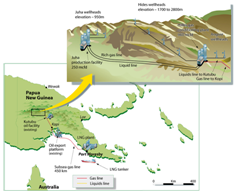
Introduction
In 2010, Exxon-Mobil’s subsidiary Esso Highlands started the construction of the PNG LNG (Papua New Guinea Liquefied Natural Gas), a USD $19 billion project to produce 6.9 million tonnes (t) of natural gas per year over a period of 30 years. The project integrates gas production and processing in the Southern Highlands and Western Provinces of Papua New Guinea, mainly in the Kutubu and Tari districts, and subsequent liquefaction and storage at Port Moresby on the Gulf of Papua to send it to thirsty foreign Asian markets mainly in China, Taiwan and Japan.
The project is currently in preparatory stages, with the company developing the infrastructure to extract and transport the gas. The construction of the pipeline covers 700 kilometers, connecting the provinces to the port (Figure 1). It is estimated that the project will generate USD$ 20 billion in revenues in the first year of extraction (2014) coming from 200 million barrels of liquefied gas. However, there are questions surrounding how much of these benefits will accrue to the people in the country, especially in the Southern and Western Highlands. Until now, local communities’ livelihoods have been affected and the environment has been modified as consequence of the company’s actions. Moreover, none of the damage to local people and the environment has been accounted for, since the government is an important investor in the project.
Click here for the factsheet (4 pages): FS_023_PNG LNG project

The project ENVJUSTICE has received funding from the European Research Council (ERC) under the European Union’s Horizon 2020 research and innovation programme (grant agreement No. 695446)